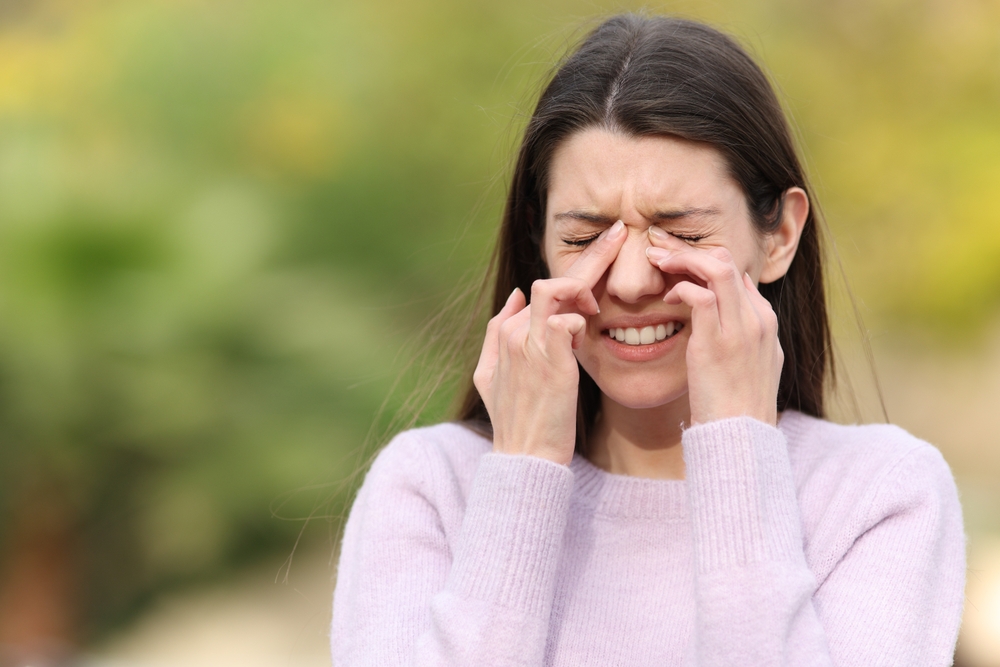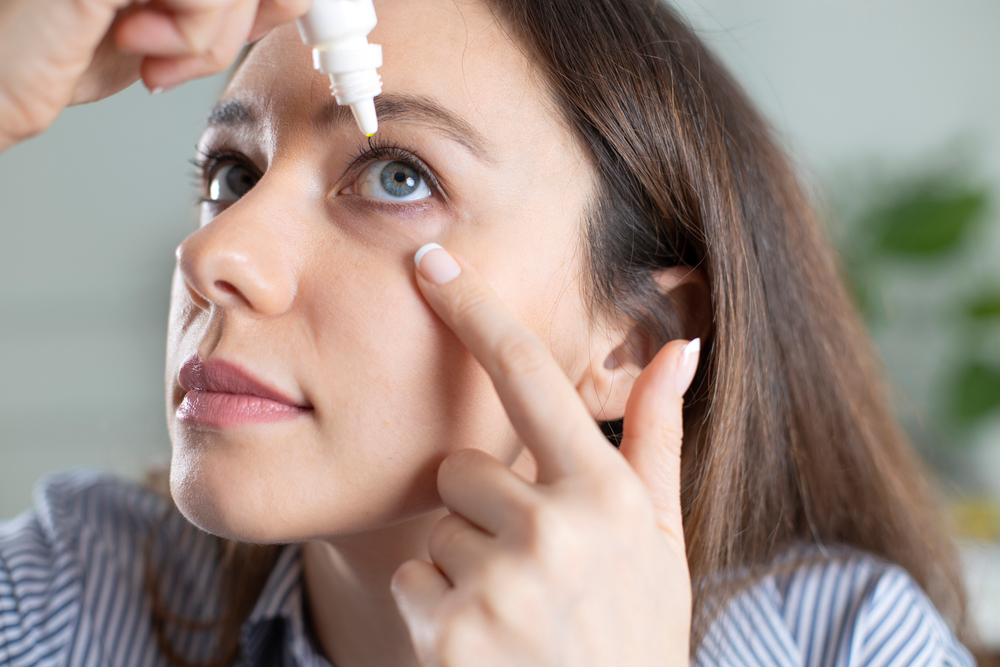If you’ve ever experienced persistent dryness, grittiness, or the uncomfortable sensation that something is stuck in your eye, you’re not alone. Dry eye affects millions and has become increasingly common in our digital age.
However, understanding what causes dry eye and knowing your treatment options can make the difference between ongoing discomfort and lasting relief. Keep reading to explore the complexities of dry eye, from its underlying mechanisms to the most advanced treatment approaches available today.
What Is Dry Eye?

Dry eye is a chronic eye condition that occurs when your tear film lacks one or more essential components needed to keep your eyes properly lubricated and comfortable. Your tear film consists of three critical layers: the outer lipid (oil) layer that prevents evaporation, the middle aqueous (water) layer that provides nutrients and protection, and the inner mucin (mucus) layer that helps tears adhere to the eye’s surface.
When any of these layers is deficient or imbalanced, your tears may evaporate too quickly, or you may not produce enough tears to maintain proper eye moisture. This disruption leads to the uncomfortable symptoms that characterize dry eye and can significantly impact your quality of life and visual comfort.
Common Dry Eye Symptoms
Dry eye symptoms extend far beyond simple dryness, presenting a complex array of signs that can vary significantly between individuals. The most common symptoms include persistent dryness that doesn’t improve over time, excessive tearing as your eyes attempt to compensate for inadequate moisture, and a gritty sensation that feels like sand or debris in your eyes.
Many patients also experience itchiness, red and irritated eyes, difficulty wearing contact lenses comfortably, fluctuating blurry vision throughout the day, stringy mucus around the eyes, sensitivity to light, and general eye fatigue. Because these symptoms can also indicate other eye conditions, it’s essential to schedule a comprehensive eye examination with your ophthalmologist at The Eye Center to ensure accurate diagnosis and appropriate treatment planning.
Understanding the Root Causes of Dry Eye
Common causes of dry eye include:
Meibomian Gland Dysfunction
Meibomian gland dysfunction (MGD) accounts for nearly 90% of all dry eye cases. Tiny oil glands, called meibomian glands, located along your eyelid edges produce meibum, the lipid layer that prevents tear evaporation.
When MGD occurs, these glands become inflamed and clogged, disrupting normal oil flow and causing tears to evaporate too quickly. Several factors contribute to MGD development, including natural aging processes that reduce meibum production, hormonal changes that particularly affect women, certain medications like isotretinoin that target oil production, and microscopic Demodex mites whose byproducts can clog glands or trigger inflammatory responses.
Age-Related Changes
As we age, our bodies naturally produce less of both the oily and watery components of tears. The lacrimal glands, which are responsible for producing the aqueous layer, become less efficient over time.
Hormonal changes can accelerate this process during menopause, certain medications, and chronic health conditions such as Sjögren’s syndrome and rheumatoid arthritis.
Modern Lifestyle Factors

Our increasingly digital world has introduced new risk factors for the development of dry eye. Excessive screen use leads to reduced blinking frequency, which is essential for maintaining eye moisture.
Contact lens overuse presents another challenge, disrupting the tear film composition, reducing oxygen flow to the cornea, and increasing the risk of infection that can inflame the meibomian glands. Similarly, eye makeup, particularly products containing powders or glitter, can flake into the eyes, causing irritation, while eyeliner applied too close to the lash line can clog meibomian glands.
Environmental Triggers and Allergens
Environmental factors play a significant role in dry eye development and symptom severity. Allergens, such as pet dander and tree pollen, trigger immune responses that irritate and inflame the eyes, disrupting the balance of the tear film.
Many allergy medications also contain ingredients that can worsen dry eye symptoms, creating a challenging cycle for allergy sufferers. Environmental irritants, such as windy, dusty, or smoky conditions, can trigger dry eye symptoms.
Additionally, indoor air conditioning and forced air heating systems can exacerbate existing eye conditions by reducing ambient humidity levels.
How is Dry Eye Treated?
Your eye doctor may recommend one or more dry eye treatments depending on the root cause and severity of your condition:
Prescription Eye Drops

When over-the-counter artificial tears prove insufficient, prescription eye drops can help reduce inflammation, increase natural tear production, and improve overall eye health. These medications are specifically formulated to address the underlying inflammatory processes that contribute to dry eye symptoms.
Platelet-Rich Plasma (PRP) Eye Drops
Platelet-rich plasma (PRP) eye drops are one of the most advanced regenerative therapies available for moderate to severe dry eye disease. This innovative treatment uses your body’s healing mechanisms by concentrating growth factors from your blood plasma to rebuild and restore damaged eye surface tissue.
The process involves drawing a small amount of blood and using centrifugation to separate healing platelets, which are then combined with artificial tears to create a highly concentrated therapeutic eye drop solution. PRP tears contain significantly higher concentrations of growth factors compared to traditional serum tears, including nerve growth factor, vascular endothelial growth factor, platelet-derived growth factor, and brain-derived neurotrophic growth factor.
These powerful growth factors work at the cellular level to stimulate new surface cell growth, accelerate healing, reduce inflammation, and restore the eye’s tear film. The Eye Center’s implementation of this advanced technology allows patients to receive a three-month supply of personalized PRP tears in approximately 60 minutes.
Low-Level Light Therapy (LLLT)
LLLT utilizes specific light wavelengths to stimulate cellular function and reduce inflammation, eliminating the need for invasive procedures. This advanced therapy helps increase tear production by gently heating and expressing the meibomian glands, improving the lipid layer of tears that’s essential for preventing evaporation.
The treatment works by enhancing cellular metabolism and promoting natural healing processes, making it an excellent option for patients seeking non-pharmaceutical interventions that address underlying dysfunction rather than merely masking symptoms.
Intense Pulsed Light (IPL)
IPL provides targeted treatment for dry eye caused by inflammation and meibomian gland dysfunction. This in-office procedure utilizes controlled light energy delivered to the eyelids and surrounding skin to reduce inflammation affecting the meibomian glands and restore normal oil flow, which is necessary for healthy tear production.
Who Is at Risk for Developing Dry Eye?
Certain factors significantly increase your likelihood of developing dry eye disease. Age is the most significant risk factor, with individuals over 50 experiencing higher rates of dry eye due to natural changes in tear production and gland function.
Women face elevated risk, particularly after menopause, when hormonal changes can dramatically affect tear production and quality. Previous vision correction procedures like LASIK can temporarily or permanently alter tear production, while autoimmune conditions such as Sjögren’s syndrome and thyroid disorders can systematically affect gland function throughout the body.
Specific eye conditions, including blepharitis, entropion, ectropion, and ocular rosacea, create additional risk factors, as do commonly prescribed medications like antidepressants, diuretics, and antihistamines that can reduce tear production as a side effect.
Get Relief from Dry Eye
Dry eye doesn’t have to compromise your quality of life or visual comfort. The Eye Center’s comprehensive approach to dry eye diagnosis and treatment offers hope for even the most challenging cases, combining cutting-edge technology with personalized care to deliver results that work.
Schedule your appointment at The Eye Center in Greenfield or Athol, MA, today!
